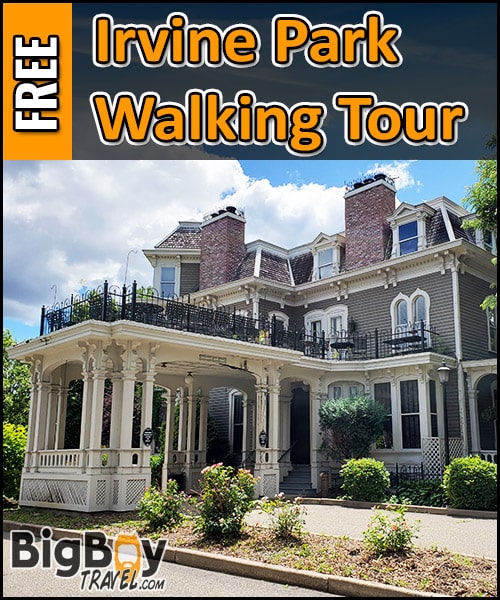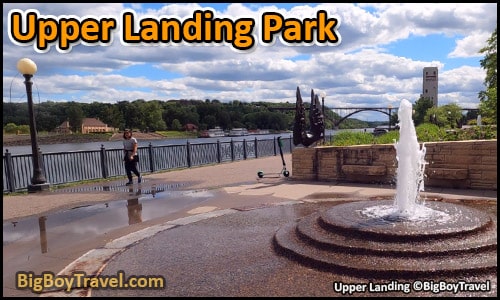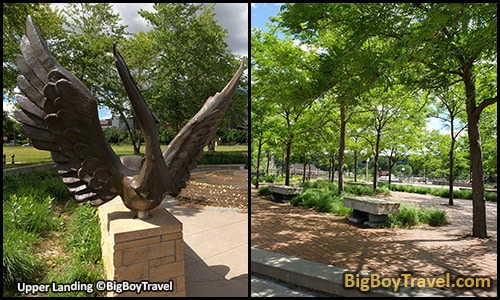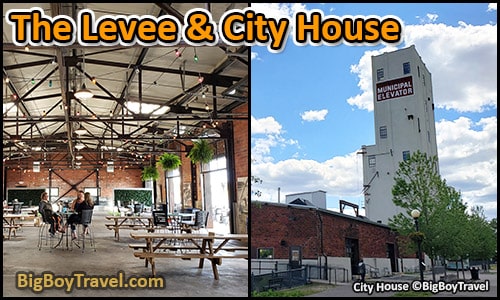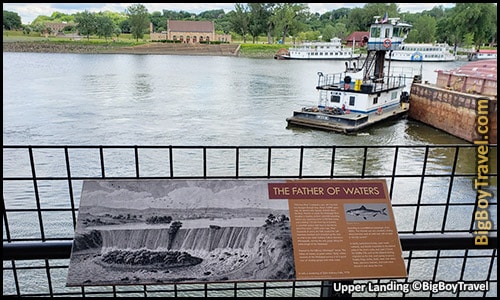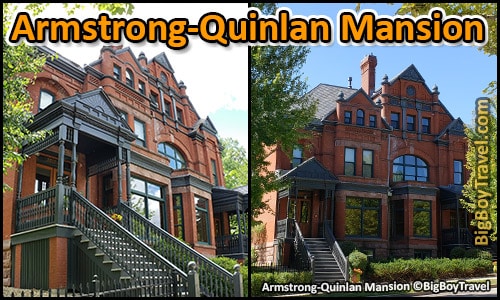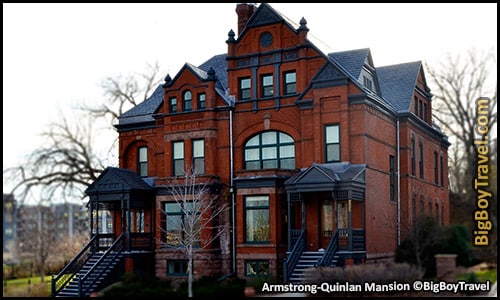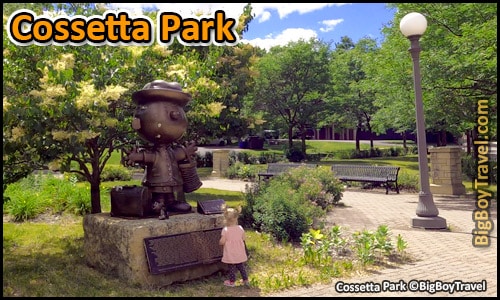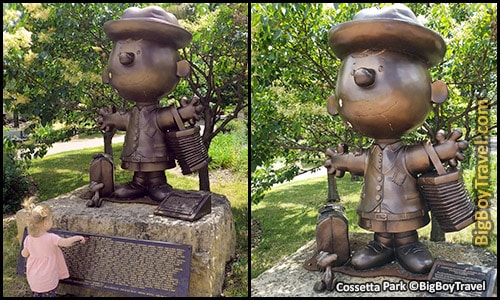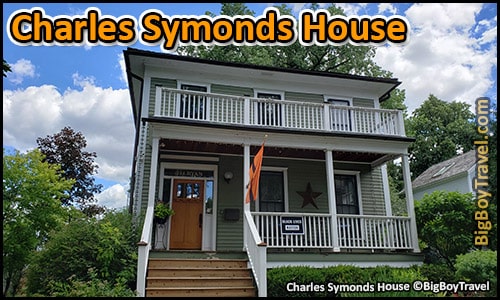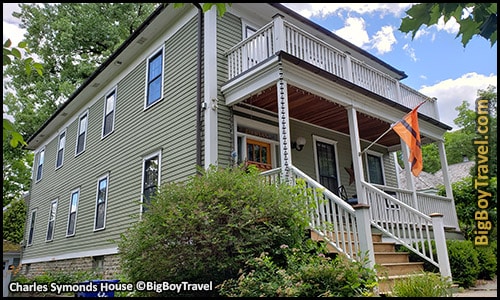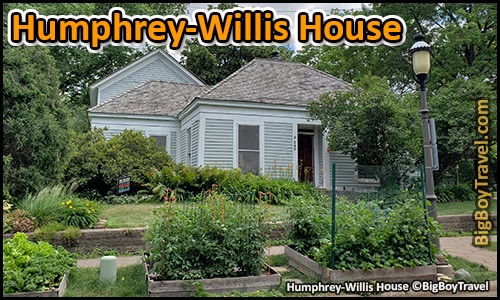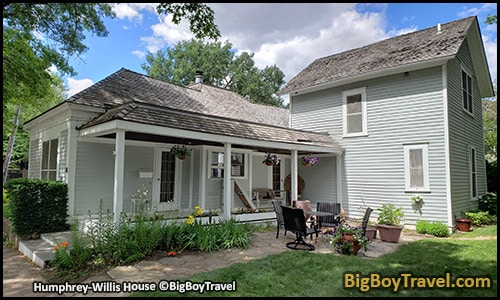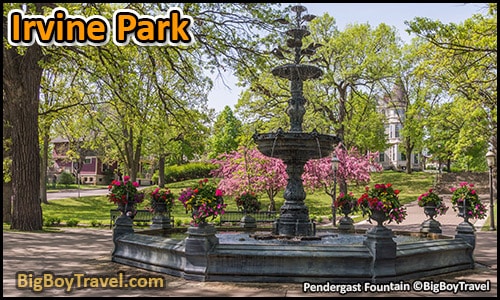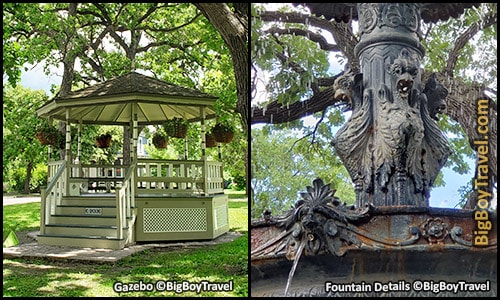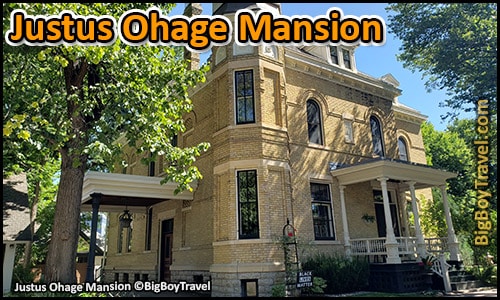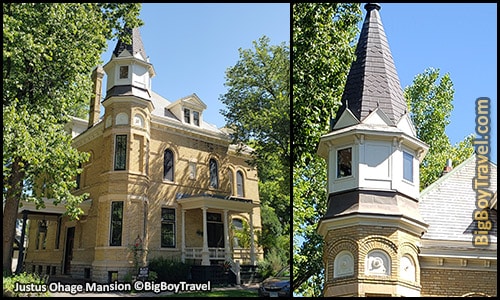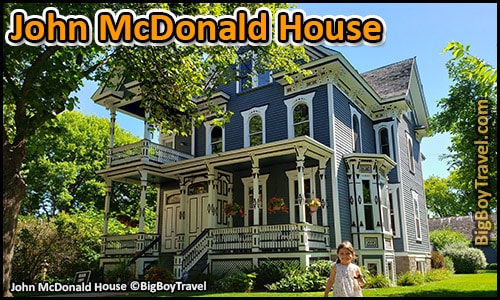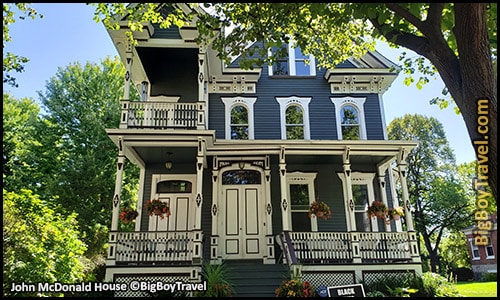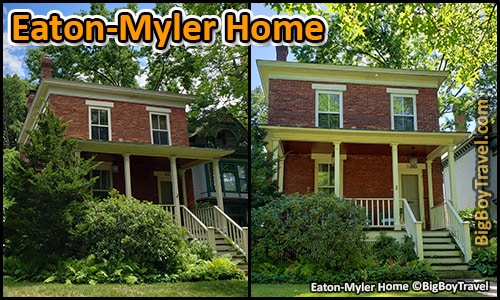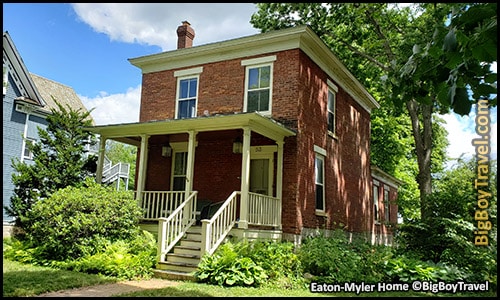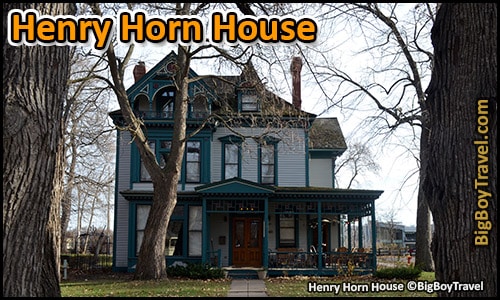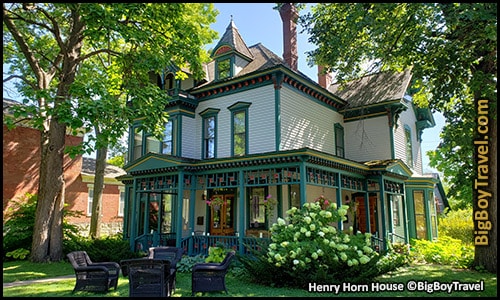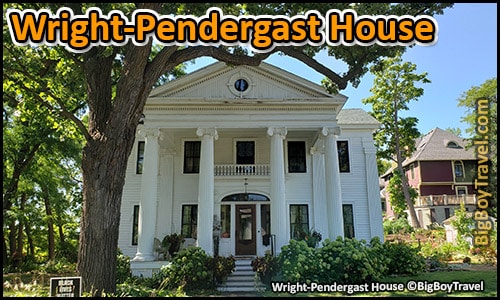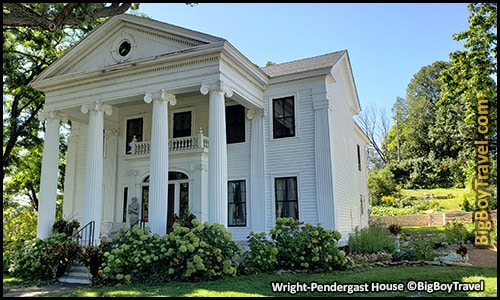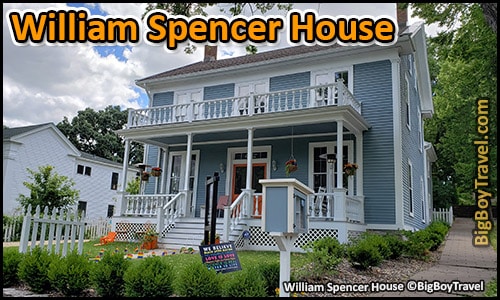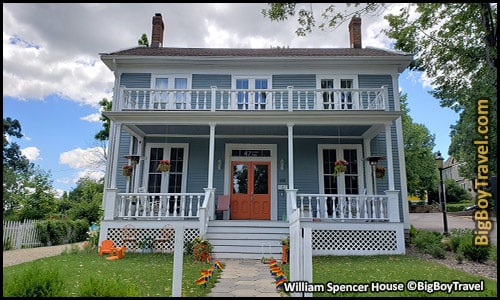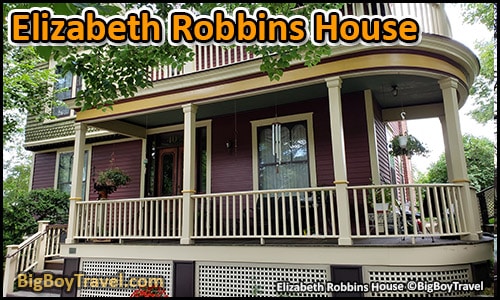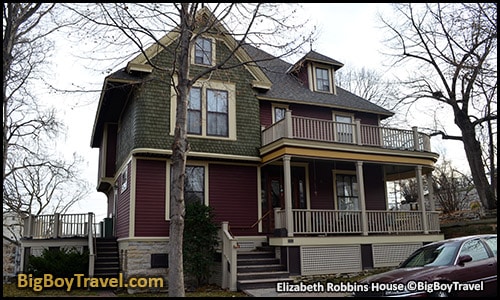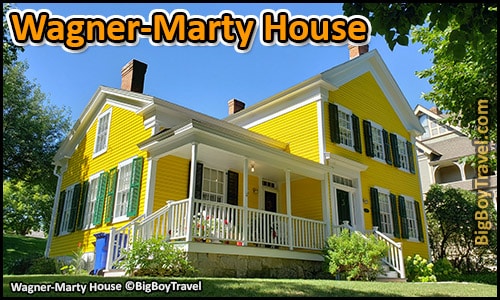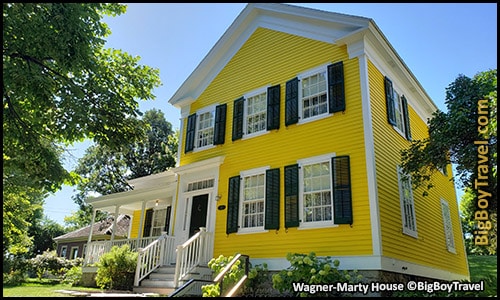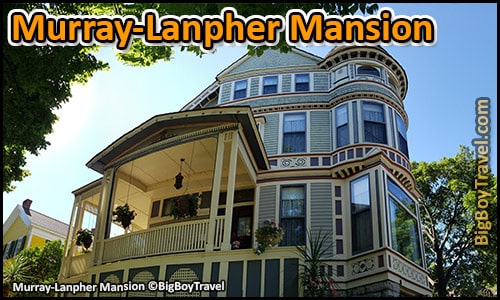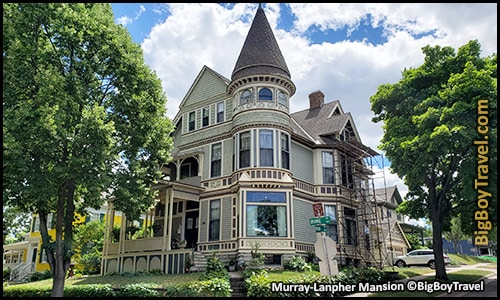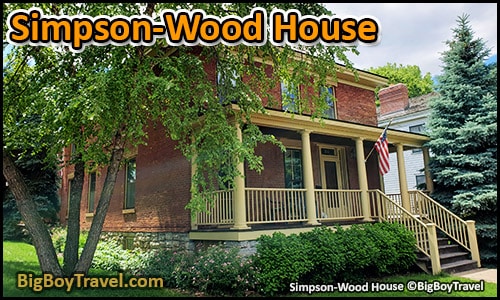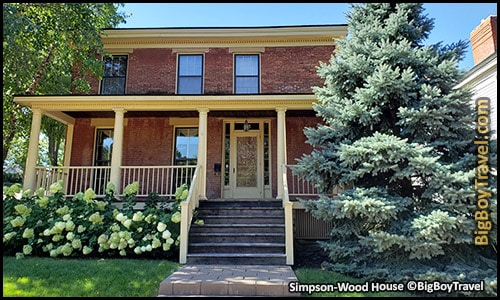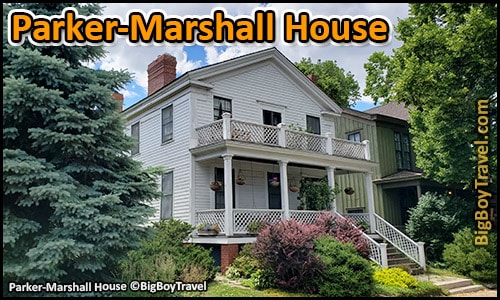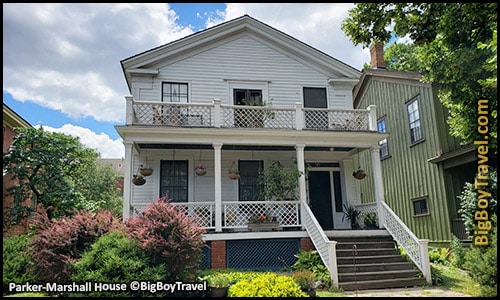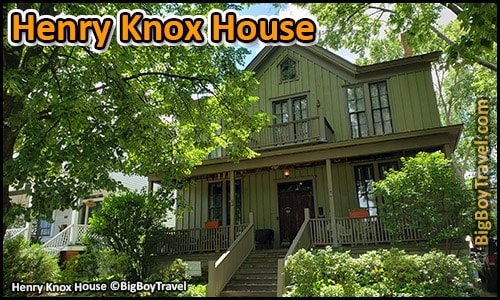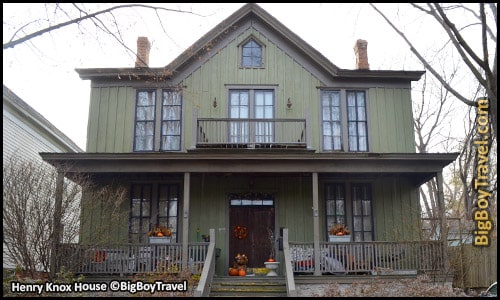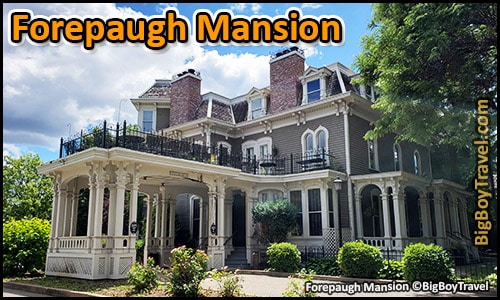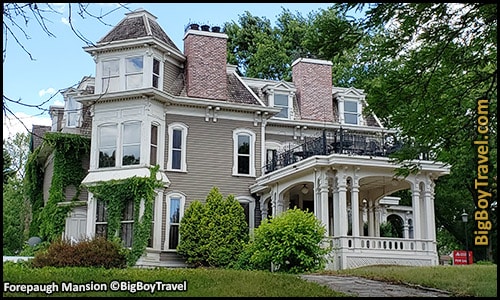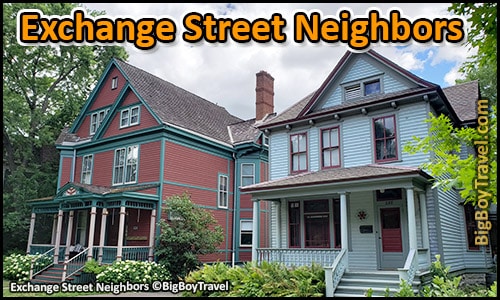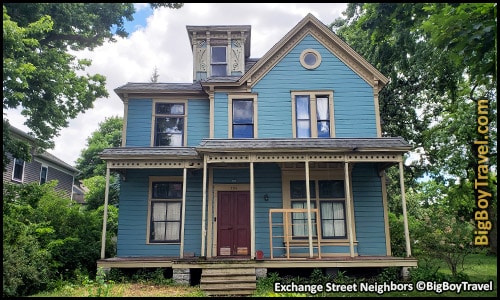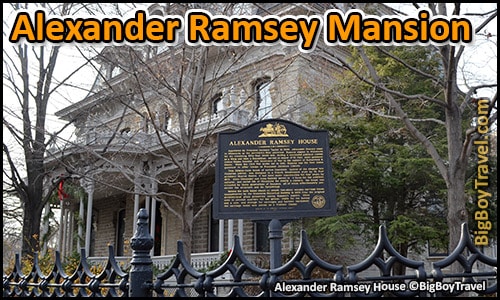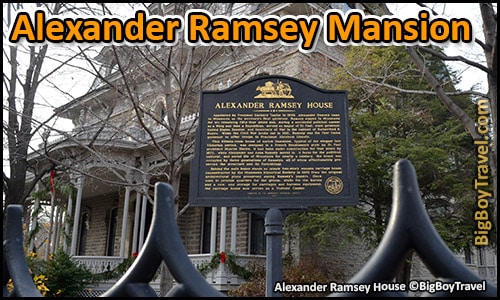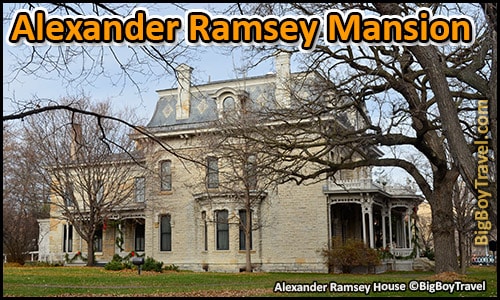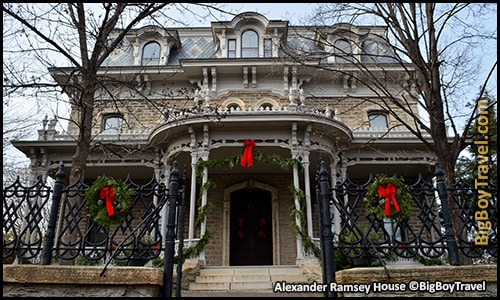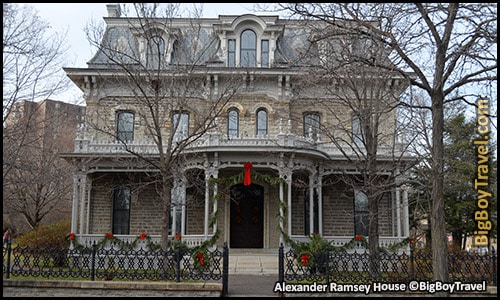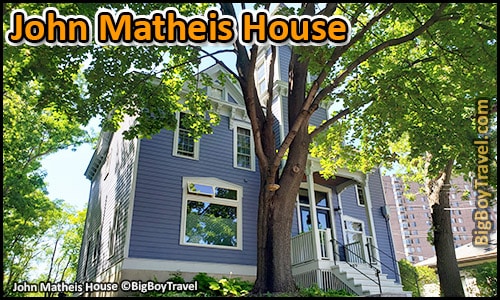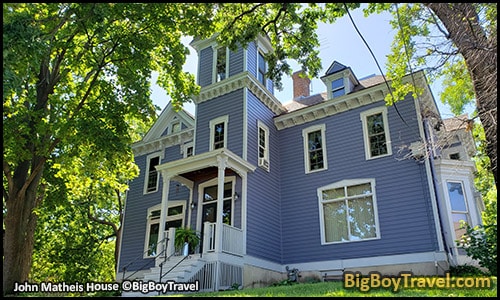Irvine Park Walking Tour:
Location: Irvine Park St Paul, Minnesota
Tour Cost: Free, Self-Guided (Optional Fees Listed Below)
Start: Upper Landing Park
End: 7th Street Restaurants & Bars
Walking Distance: 1 to 1.3 Miles (Assuming a complete loop)
Time: 30 Minute Walk (2-3 hours with restaurant stops)
Fun Scale: 8.5 out of 10
Overview of Irvine Park:
Taking a stroll around the historic neighborhood of Irvine Park is one of Saint Paul’s hidden gems. Settler John Irvine arrived here in 1843 and purchased the Mississippi River’s Upper Landing boat docks and the surrounding 300 acres of what was recently ceded Dakota lands. Irvine cleared the forested land for three years and as he began platting out development, he donated the area of today’s park to the city of Saint Paul as a pasture in 1849, the same year the Minnesota Territory was established.
The area around Irvine’s pasture became the first true neighborhood in the Twin Cities and the area quickly gathered stately homes and notable families from barons to Governors. Roaming cows made way for a formal New England-stye park complete with gas lighting in the 1870s and a decade later it had a stunning central fountain.
Over the early decades, some of Irvine Park’s wealthy families moved up to Summit Avenue but the neighborhood stayed strong. Once the Great Depression hit, however, the area started a slow decline that eventually peaked in the 1970s when over 90% of the homes had become were nearly unlivable. While a number of the original mansions had to be torn down, other historic homes from around Saint Paul were moved here to fill the void and the park’s perimeter has become a refuge for relocated mansions. Today, Irvine Park is a pocketful of peacefulness and preserved mansions near the heart of Saint Paul, giving you a small window into its past greatness. And did we mention this free walking tour also has Saint Paul’s most haunted home?
Irvine Park Walking Tour Sights:
1. Upper Landing Park (178 Shepard Rd):
About Upper Landing Park: The story of Saint Paul’s growth really starts at Upper Landing which served as the center of shipping and cargo for the growing city in the mid-1800s. Because of rapids further upstream, toward present-day Minneapolis, this area was once as far up the Mississippi River that large boats could go. This navigational hurdle helped make early-day Saint Paul the gateway to the rich lumber and minerals in northern Minnesota. The riverfront near Upper Landing quickly grew into working-class immigrant neighborhoods from German, Italian, Irish, Czech, and more. The Little Italy neighborhood just South of Upper Landing, known as the Levee, was one of the quickest to grow.
As regional rail lines became stronger and river traffic ventured further North past the rapids, business at Upper Landing strongly declined in the early 1900s. Many of the immigrant residents of Upper Landing’s riverfront stayed until constant flooding in the mid-1950s finally ended the Landing’s run. In more modern times, the Upper Landing has received a full makeover into a pleasant riverfront park, and it is proudly one of the best places in the Twin Cities to watch the 4th of July fireworks.
Historic Photos: (Flooding in 1952).
2. The Levee & City House (258 Mill Street):
About The Levee & City House: Such an important place for the development of Saint Paul.
City House Hours: Daily 11am-9pm from the Spring through the Fall. City House Website: Here. Historic Photos: (Flooding in 1952).
3. James Armstrong Mansion (225 Eagle Parkway):
About The Armstrong-Quinlan Mansion: As you follow our Irvine Park walking tour, you’ll notice that many of the homes were moved to this neighborhood to save them from demolishing. Even the massive 10,000 square foot Armstrong-Quinlan Mansion was moved to Irvine Park which was no small feat (more on that below).
In 1873, George Washington Armstrong (Minnesota’s 1st Territorial Treasurer) bought a piece of land that was then on the outskirts of Saint Paul. Looking at it on the map, the land was two blocks West of today’s Excel Center, while early day Saint Paul Proper was still centered around Mears Park.
As the city quickly grew, his brother John Milton Armstrong (only 20 years old) was willed the land and built this gigantic mansion as a side-by-side double-house (duplex) in 1886 which the family held and rented out until 1943. It amazes us that a duplex in this era of Saint Paul was built on such a grand scale and so cohesively made to look like a single-family mansion.
After spending a period as a center for recovering alcoholics, the Armstrong Mansion became the Quilan Nursing Home in 1965. By that time, all of the residential homes in the area around Seven Corners had been slowly removed or replaced, leaving the Armstrong-Quinlan Mansion all alone. As the only surviving Victorian Era mansion in the neighborhood, it was at risk of being demolished in the 1980s until preservationists got it added to the National Register of Historic Places in 1982. This forced the city to look for buyers instead of knocking it down and they eventually bought it themselves in 1988 to use as an art school that never opened.
By this time in 1988, the gigantic Armstrong-Quinlan Mansion was sitting all alone in an empty parking lot two blocks West of the Saint Paul Civic Center (now the Excel). The mansion sat vacant for 13 years while the city looked for buyers. After finding no buyers willing to also move the home, the City of Saint Paul eventually had to pay $2.4 million to move the mansion themselves. This extensive move took 6 months of preparation, over a week
had to raise it up 8 feet to move and rebuild the foundation stone by stone (modernized), 9 days, 120 streetlight, fire hydrants, street signs all had to move, had to pivot 90 degrees before going down Chestnut Street, in one place the 60-foot-wide mansion had to go through a 64-foot-wide space, they had to use dump trucks fill with sand to counterweight the mansion as it went down Chestnut’s 6.5 degree slope.
Historic Photos: (Home at old Location in 1949). Video Of Home Being Move: Here.
4. Eagle Street Plaza:
About Eagle Street Plaza: As you head up Eagle Street Parkway make sure to take in the views to the West of the beautiful St Paul Cathedral preached high above the city. Before taking a left on Ryan Street make sure to check out the tiny park sitting almost in the middle of the street called Eagle Street Plaza. Almost hidden in the bushes a cool bronze statue of Charlie Brown which is a homage to Charles Shultz, the creator of the Peanuts characters who grew up in St Paul.
Next to the statue is a plaque in honor of the Italian immigrants of early day Saint Paul who came here to pursue the American dream. Knowing no one in a new land they sacrifice they sacrificed so the next generations of their family could have better lives. These immigrants mainly lived in St Paul’s Little Italy near the River called the Levee which was formed in the 1900s. They were joined by Bohemians, Germans, and countless other groups that made up emerging St Paul’s working-class helping the city to grow.
In 2015, the plaza was officially renamed Cossetta Park which is fitting given the location. In the late-1800s, Michael Cossetta moved from Italy to settle in Saint Paul’s Leeve near Upper Landing. By 1911, he had opened a food market and eventually Coesstta’s Restaurant was born. The local favorite eatery has been located nearby at the intersection of 7th Street West (Fort Road) and Chestnut Street since 1984.
5. Charles Symonds House (234 Ryan Ave):
About The Charles Symonds House: This home was originally built in 1850 two blocks away facing the Mississippi River and is often incorrectly called the oldest home standing in Saint Paul. The Henry Knox Home on the opposite side of Irvine Park is actually the oldest from 1849 and we will visit it later on this walking tour.
This home’s first owner, Charles Symonds, was a sea boat captain who often worked out of the nearby Upper Landing and wanted to live close by. He was also most notably Saint Paul’s first ice dealer and lived in the home until 1883 when he sold it. Thirty years later, the Upper Landing having worse than normal flooding issues the Symonds home was spun 180 degrees moved to its current location.
By 1973, this home was in very rough shape with rundown siding and a gloomy, closed-in porch. Thankfully the Symonds House was beautifully restored back to life, the porched was opened back up, and the spindle balcony returned. The neighbor directory to the North wasn’t as lucky and was eventually torn down.
6. Humphrey-Willis House (240 Ryan Ave):
About The Humphrey-Willis House: Sitting on the edge of Irvine Park, the Humphrey-Willis House from 1851 is tied as the 3rd oldest house in Saint Paul. The quaint white cottage is rather plain compared to its neighbors but is one of the few in its original location.
It is also one of the best examples of early pioneer architecture as lawyer, and first Ramsey County clerk, James Humphrey built it in 1851 to serve as a honeymoon cottage with his fiance Harriet Bishop. If that name sounds familiar it is because Bishop was a teacher who was Saint Paul’s first educator and was a strong voice in both the Temperance Movement and women’s suffrage. Humphery’s wedding with Bishop was eventually called off and two years later the home was sold to Charles L Willis in 1853.
The two-story addition seen in the Northeastern back corner of the home was added in 1886, but it is no ordinary expansion. This structure is actually the original home of John Irvine who developed the neighbor which we will talk more about next on this walking tour. It is also worth noting that the John Irvine home was built two blocks away closer to the river and was actually then next to the Symonds House we just saw. We find it really cool that they get to be neighbors once again at their new Ryan Street location.
7. Irvine Park:
About Irvine Park: The center and cornerstone of the entire neighborhood is the delightful Irvine Park itself which dates back to 1849. This was the same year that the Minnesota Territory was established with Saint Paul as its capital and is 7 years older than New York’s Central Park. There were actually 3 main parks in Saint Paul all set in motion by land donated in 1849 including Mears Park in Lowertown (from Robert Smith), Rice Park in Downtown (from Henry Rice), and Irvine Park (from John Irvine).
Initially, Irvine Park’s untamed center was used as a commons with roaming cattle and homes mainly facing the Mississippi River. In 1872 more concrete development began and the park was officially named after shipping magnate John Irvine who not only donated the land but plotted out the neighborhood. During the development, the land was so untamed that it took over a month to clear out the wild underbrush and level the grounds into a proper park. As a proper finishing touch to the project, the Pendergast family installed a beautiful 3-tiered fountain in the center of the park in 1881. You’ll notice that Irvine Park’s crossroads radiate out from the central fountain in a New England-style stead of lining up with the corners of the park. This layout is unique for a Twin Cities park and helps to keep the entire space feeling like a cozy time capsule that is cornered off from the neighboring bustle.
Just before the Great Depression, the city no longer wanted to maintain the park so they scrapped the fountain in 1927 and stripped its park status in favor of a low-budget playground. This move, along with hard times, and many of the neighborhoods wealthy moving elsewhere like Summit Avenue, led to a slow decline of the Irvine Park Neighborhood. Many of the homes were divided into multiple-unit rental homes or boarding houses and their maintenance was ignored. By 1973, when a preservation group was set up, over 90% of the homes were declared inhabitable by the city and the playground was a rusted waste of space.
Luckily, the City of Saint Paul got involved in the 1970s and decided to turn the area back into a park to revitalize the neighborhood. The largest change was tearing down some of the forgone homes and filling the void by relocating other historic towns from around Saint Paul that otherwise would have been demolished. In addition, the rusty playground equipment was removed and a new fountain was made to loosely match the original one. The fountain’s replacement cost may sound reasonable at $40,000, but it was a far cry from the $900 it took to build the previous fountain a century earlier. Over the decades since, the revitalization efforts have worked as the Irvine Park neighborhood has hit a renaissance and has become the most popular park for weddings in Saint Paul. As much as we like the collection of homes, we especially love sitting in the park’s gazebo on Summer evenings while doing nothing at all.
Historic Photos: (Fountain in 1885 | Park in 1888).
8. Justus Ohage Mansion (59 Irvine Park):
About The Justus Ohage Mansion: German-born Doctor Justus Ohage (Yo-stos O-ha-ja) built this large three-story home for his American wife Augusta in 1889. It was just 3 years earlier that the renowned Dr. Ohage performed the Nation’s 1st successful gallbladder surgery (cholecystectomy) at Saint Paul’s Saint Joseph Hospital.
The home’s yellow bricks and tower were supposed to be like Augusta’s childhood home in Saint Louis Missouri. Tragically, the same year the family moved into the mansion, Augusta (age 34) died during childbirth followed by the baby (Thecla) dying a few days later. It was utterly devastating and left Doctor Ohage to raise their five surviving children alone.
This wasn’t the only heartbreak the Doctor had as just one year earlier the couple’s 6th baby (Arthur, 5 months) died of a respiratory infection. Two years after his wife’s death, the couple’s firstborn son (George, 22 years) also died after a long bout of Tuberculosis Meningitis. Doctor Ohage was his son’s attending physician and even had to sign his own son’s death certificate. During all of the heartache in that two-year span, Ohage (former Civil War veteran) dedicated himself to his work and his children while never remarrying.
In addition to being a doctor, Ohage taught at the University of Minnesota and was Saint Pauls’ first public health officer (1899-1918). He was really into promoting the public’s general health from vaccinations to trash cleanup. In 1900, Ohage donated the land he owned just across the Mississippi River on Harriet Island (named after Harriet Bishop) to the city to become a park. He felt that it was important to have access to healthy living in the center of town which included exercise equipment, playgrounds, bathhouses (swimming beaches), and even a public zoo. The bathhouses thrived for years before closing from ongoing river pollution and the zoo moved to Como Park (Como Zoo) in the 1930s, but Harriet has remained one of Saint Paul’s important parks.
By the time wide-scale restorations started in Irvine Park in 1973, the Ohage Mansion needed a lot of work. The peak on the top of the tower had been reduced to a stump and it needed a lot of general repairs. We love seeing the tower as its pointy self again with Doctor Ohage’s Mansion once again back to full health.
While the current home dates to 1889, there was an older home on the site as early as the 1870s which was built by famed explorer Nathaniel Pitt Langford. During scouting for the Northern Pacific Railroad on the Washburn Expedition of 1870, Langford became the first pioneer to see Old Faithfateful geyser in Montana. Not only would it became Yellowstone National Park, but Langford was the first park superintendent. Because the position was non-salary, Langford was a bit absentee and it only lasted for 5 years before he moved back to Minnesota along Irvine Park. In his later years, Langford served as the President of the Minnesota Historical Society.
Historic Photos: (Home 1936 | Home 1972 | Home 1979 | Bathing Beach 1900)
9. John McDonald House (56 Irvine Park):
About The John McDonald House: Sitting next to the yellow Ohage Mansion is an even brighter colored blue home was built by architect John McDonald. McDonald was a skilled craftsman who also built nearby homes at 39 Irvine Park which has since been torn down (photo) and also the beautiful home still at 35 Irvine which you will see shortly. The details of the paint and woodwork combined with the interesting architectural lines of the home in front of you make it our favorite one facing Irvine Park. If you peek around the side of the house it is over two houses deep and seems to go on forever.
This blue beauty wasn’t always at Irvine Park as McDonald actually built it at 362 Smith Avenue in 1871, but its move to the current location made it a legend. During the home’s relocation to its current lot in 1978, it sat overnight on a flatbed semi where it got a ticket for being illegally parked. This was the only time a Twin Cities home (excluding trailer homes) has ever received a parking ticket. Knowing the history of the house makes it almost ironic that there is a no-parking sign on the street nearby.
Historic Photos: (House in 2001 before painted details added to white trim).
10. Eaton-Myler Home (53 Irvine Park):
About The Eaton-Myler Home: This red brick home was built by Alonzo Eaton in 1853 on the corner the Excel Center now sits (190 West 7th Street). James and Catherine Myler bought the home in 1882 and ran it as a hotel for a couple of decades. The Salvation Army later purchased the lot in 1979 and was going to tear down the house until Lance Belville bought it and moved it to its current location in Irvine Park.
11. Henry Horn House (50 Irvine Park):
About The Henry Horn House: Before you even check out this house, head right for the awesome carriage step (photo) with the house number on it near the curb. Because most of the homes near Irvine park were built before the common use of cars, they all had their own roadside step to help visitors get into and out of their carriages. This interesting home itself was built in 1869 for pastor David Riddle Breed and was originally twice as big with a front door facing the river.
Pastor Breed only lived here for 5 years before selling it to military surgeon Jacob H. Stewart who served 5 terms as the mayor of Saint Paul (1864-65, 1868-69, & 1872-75). Stewart moved in during his last year as Mayor after which he was also elected for a term as a US Congressman (1877-79). In 1881, Stewart sold the home to his neighbors Henry and Fanny Banning Horn and left public service to get back into his medical practice which he did until his death in 1884.
The Horns, who previously lived in a home where the neighboring red brick house sits today, are the ones responsible for the current playful look of the house. Henry Horn, who was a local attorney, made a ton of improvements to the home from adding the ornately carved woodwork to the exterior to moving the front door from the Mississippi Riverside to face the Irvine Park. Henry’s wife Fanny is the one that split it into a double house up and down apartments after Henry died.
Unfortunately, by the 1970s this home had been turned into a duplex that was derelict almost to the point of shambles due to very poor maintenance. Simply put, it was a dump. Putting more gas on the fire, the back half of the Horn Home (Northeast corner) burnt down in 1980, but a majority of the gigantic house was thankfully saved. If you look at the photo below from 1972, you can see how far the renovations have come in restoring the design and colorful woodwork from Horn’s original renovations.
Historic Photos: (1888 | 1972 | 1974 Side Profile). Our Photos: (Carriage Step | Porch Details | Side Profile)
12. Wright-Pendergast House (223 Walnut Street):
About The Wright-Prendergast House: Built in 1851, this is the second oldest home in Saint Paul still sitting at its original location. In a park surrounded by an eclectic group of architectural styles, this White House-like home with its large Greek columns is one of the most unique. As you admire the property, remember that at the time it was built in 1851, most of the new homes in Saint Paul were small, dirt-floor log cabins.
Canadian carpenter Isaac Wright built this distinguished home in 1851 and he lived here until his death in 1906. It might not seem like a big deal, but in a neighborhood of constant turnover, it is amazing that Wright stayed in one house for 53 years. The side-lawn or Wright’s mansion served as the 1st tennis court in St Paul when it opened in 1885 thanks to the Delta Lawn Tennis Club.
After Wright passed away the home was sold to local plumber James Joseph Prendergast. The Pendergast family was well known in St Paul and James’ uncle was the one who installed the original fountain in Irvine Park in 1881. James drastically changed outside of the home after buying by adding the huge Greek column portico to the front. Prior to drastic this change to the facade, the home looked just like the Williams Spencer (47 Irvine Park) home we will visit next on this Irvine Park walking tour. In addition to the front of the home, Pendergast also re-did much of the interior with parts of other Saint Paul mansions from the 1800s that were scheduled for demolition. Because of his connections as a plumber, Pendergast had a leg up in picking the best items from the other mansions.
Many of the new interior elements came from the inside of the Kittson Mansion which was being torn down to make way for the Saint Paul Cathedral on Shelby Hill (now called Cathedral Hill). Kittson had served as the Mayor of Saint Paul and his home had been considered one of the finest in Minnesota before his death in 1888. All of the chandlers and mantles in the home as well as the marble fireplace came from the Kittson Mansion. Our favorite item salvaged from the Kittson Mansion is a beautiful stained glass window depicting Arachne the Weaver (industry) from Greek mythology. This priceless window is said to have been made by artist John LaFarge and once hung in the Kittson’s stairwell.
In 2013 the Jensen family bought the home for $412,000 becoming just the 3rd family to own the property. They had to do very extensive restoration work to get the home back in shape, but if the longevity of previous owners holds up the Jensens will be here a long time.
Historic Photos: (Home in 1936 | Tennis Club in 1885 | Another Tennis Club Photo from 1885).
13. William Spencer House (47 Irvine Park):
About The William Spencer House: This delightful blue home with 10-foot-tall windows, a two-level spindle porch, white picket fence, and a little library stand is maybe the coziest on Irvine Park today. The Spencer property is an idyllic family home that almost looks like it is out of a movie set. The one negative about the home is that it has an unusually small lot for the neighborhood that was divided after the previous house here burned down in 1857.
Attorney William Austin Spencer and his wife Marie had the current home built from 1859-60 on the foundation of the burned-down house after moving here from Utica, New York. Like many early Irvine Park settlers, the Spencers were from New England and had very prestigious social connections. William had used some of his connections to found the Republican Party of Minnesota and was rewarded with an appointment to be Clerk of the US District Court by President Lincoln. The family lived a prestigious life mixing with high social circles and even sending their son Edward to Yale University.
In 1891, the Spencer family moved two doors down into a large home built by John McDonald at 39 Irvine Park (now razed, photo). This second home had a barn-shaped roof and a stumpy central tower along the front. With the family moved out, the original Spencer home was eventually turned into a 4 unit rental called Walnut Flats which seems cramped for its size. Eventually, William died (1897) and when their last adult child passed away in 1941, both homes were on the decline. It was so bad that the home at 39 Irvine had to be torn down by the 1970s and the original home was still in rough shape when we first visited it in 2010. While the second home is now an empty lot, luckily the remaining Spencer home was fully gutted and renovated in 2019 into the beauty you see today.
14. Elizabeth Robbins House (40 Irvine Park):
About The Robbins-Semple House: Also known as the Robbins-Semple House, this extremely well-kept home was built for Elizabeth Robbins in 1887. Elizabeth and her husband Samuel Loring Robbins had lived just off of the park and the couple had an enormous book collection. When Samuel died in 1883, she started designing the new home which had a large library as its centerpiece. It is often referred to as the Robbins-Semple House because Elizabeth lived here for 22 years with her unmarried sister Annie Semple.
The Robbins home hasn’t aged a day since the 1800s and we love the shingle siding on the second floor and the modern paint colors. The two-level wraparound porch on the front of the house is our favorite feature. Here is a photo of the house while it was owned by Louis Johnson in 1911. Because the home has been so well kept, we feel it doesn’t look as old as the others on this Irvine Park walking tour.
Historic Photos: (Home in 1911 | 39 Irvine in 1968 | 38 Irvine in 1919).
15. Wagner-Marty House (38 Irvine Park):
About The Wagner-Marty House: Originally built in Woodbury in 1852, the current yellow Wagner-Marty House was transplanted in 1956 for the building of Highway 12 and then again in 1983 after being displaced for the expansion of Highway 94.
The first owner of the home, Nicholas Wagner, was a very successful blacksmith and wagonmaker. It is believed that the house was more of a Summer vacation home as the family including his wife Barbara and their 9 children lived full-time in Saint Paul. Sofia Marty bought the Woodbury which gave it the name the Wagner-Marty House, but unfortunately, we do not know much about her family at this time.
On the empty corner lot next door, there was once another large home at 39 Irvine Park that was torn down in 1968 (Photo). At the same time, a huge Queen Anne mansion from 1857 called the Eaton- Smyth House that stood at 38 Irvine Park was also torn down (Photo from 1919). A new home was then moved here from the East side of Saint Paul which burned down in 1979. This makes the current brightly-colored home, the third house known to have occupied the lot.
16. Murray-Lanpher Mansion (35 Irvine Park):
About The Murray-Lanpher Mansion: The wealthy barrel maker Michael Murray had John McDonald (56 Irvine Park) build this Queen Anne-style home for his family in 1887, but he died of pneumonia right before they could move in. Murray’s wife Ellen and their six kids still moved in and quickly turned it into a makeshift boarding house to make extra money.
The next couple of owners included a guy named Lanpher, who sadly neglected the home’s maintenance turning it into an almost unlivable dump by the 1970s. The home was in such bad shape that the top of the large corner tower was missing its top and it had horrible patchwork siding almost made it unrecognizable from the beauty it is today.
Luckily the couple who bought the old Murray home in the 1970s had a wonderful eye for detail and did a great job restoring the home to its former beauty. Today the Queen Anne style shines through and little things like the vines on the steps leading to the front door will make you love the house.
17. Simpson-Wood House (32 Irvine Park):
About The Simpson-Wood House: The inviting red-brick Simpson-Wood House was built in 1853 by the civil engineer James Hervey Simpson. The original location for this Federal-style home was just one block to the South at 255 Sherman Street. While this prior address doesn’t exist anymore, the home was basically across the alley found behind it (619 South Ryan Street) but facing the same direction it does today.
The home was bought by the Minnesota Valley Railroad agent Charles Wood in 1864. We don’t know a lot about Charles except that he got in trouble with the law after being accused of stealing $10,000 from his company to which his only defense was that the bag of money fell off the Wabasha Street Bridge. In the courtroom, his wife Annie Rogers Wood’s dad and brother apparently beat up the judge which didn’t help his cause. After becoming a rental in 1920, the Simpson-Wood was eventually transplanted to the current location in 1976 and restored.
Our Photos: (Side view with seam).
18. Parker-Marshall House (30 Irvine Park):
About The Parker-Marshall House: One of the more famous homes on Irvine Park is the white Parker-Marshall House. It was originally built in 1851 more or less where it sits today facing Irvine Park and is the last surviving structure from the Parker homestead farm. The farm took up most of the Southern area of the neighborhood in the late 1840s, but Rodney & Elizabeth Parker focused on running Henry Rice’s nearby luxury American House Hotel at Seven Corners (West 7th and Kellog) after it opened in 1849. The hotel was at the center of it all hosting political guests and also served as the Supreme Court for the Minnesota Territory.
The Parker-Marshall House gained closer ties to politics when William Marshall, the former 5th Governor of Minnesota (1866-70), became its renter (1877-82). Marshall was family friends with the Parkers and even served as a pallbearer for Rodney’s funeral in 1872. The former governor was spread across many business endeavors had been extremely influential in Saint Paul’s development. His efforts included building the first bridge over the Mississippi River (1958), owning the Saint Paul Press, and at the time he lived in the home he was serving as the State of Minnesota’s 1st railroad commissioner (1875-81).
In 1883, the home was moved across the street to the East to 250 Sherman Street. This block doesn’t exist anymore, but essentially it was directly behind the Murray-Lanpher Mansion we just visited on this walking tour where the garage is today. After 70 years on Sherman Street, the Parker-Marshal House was finally returned to its original location in 1853 in the place of a rundown brick apartment building.
19. Henry Knox House (26 Irvine Park):
About The Henry Knox House: Built in 1849 this is the oldest home standing in Saint Paul and tied with the two oldest homes in Minneapolis which are the Ard Godfrey House (Saint Anthony Main) and John Stevens House (Minnehaha Park). This was also the year when Saint Paul became the capital of the Minnesota Territory so it is remarkable this a pioneer-era home from 1849 in this central neighborhood would still exist. If you want to find the oldest home in the Twin Cities, that title belongs to the Henry Hastings Sibley home which was built for the State of Minnesota’s first governor in 1835.
The spooky home’s best-known resident was its namesake Henry M. Knox from 1863 until 1888. In business with his brother Jay Knox, the two were among the most successful bankers in the early days of Saint Paul. Their office, like many of the bank house, was located at the nearby Seven Corners (7th & Kellogg).
The Knox House is the only Gothic Revival-style home in the Irvine Park neighborhood. We find the home to have a somewhat creepy exterior mainly due to the dark green paint and super old windows. The creepy vibe actually makes the home charming and we love the weathered look of its wood steps and old-world front door. To get an idea of how old the home is, check out the vertical plank siding which is very unique compared to other old homes in the area. The old siding was actually hidden for decades after being buried by stucco in 1910 (by Andrew Theodore Sherwood) and was discovered during a renovation.
For some reason, many websites have this house listed as 1860, but the plaque on the outside and all of the historic records we’ve found confirm 1849. This discrepancy seems to because at some point the address was either changed from #7 to #26 or the home was physically moved from the Northwest corner of Irvine Park.
21. Forepaugh’s Mansion (276 South Exchange):
About The Forepaugh Mansion: This elegant Victorian-style mansion with its classic carriage port may look beautiful, but it is one of the most unlucky places in Saint Paul. Some people say it is haunted, others say it is cursed, but at a minimum, its inhabitants have been unlucky.
During the Civil War, Joseph Forepaugh owned the biggest dry goods warehouse in the Midwest and got super rich selling them to the Union Army. Forepaugh, pronounced 4 Paw, got so rich that he was able to retire early in 1868 at only age 34. To show off his wealth, Joseph had this huge mansion built in 1870 which is one of the most beautiful and spookiest homes in Saint Paul. Even for its day it was a large property built across 3 lots and then expanded across 5 more for the wealthy family’s formal gardens.
The drama at the Forepaugh home started early into Joesph’s young retirement when as began falling into a depression. It’s said that to help cope with his depression, Forepaugh started having affairs on his wife Mary. One of these affairs led to Joseph falling for a housemaid named Molly which his wife quickly caught on to. After making him break off the affair, the maid Molly hung herself to death by tying a rope from the mansion’s 3rd story chandelier and jumping out the window. Making matters worse, the family found out that Molly the Maid was pregnant with Joseph’s baby when she died.
As you can imagine the whole situation around the affair created problems so the family decided to quickly sell their home to General John Henry Hammond in 1886. General Hammond was longtime friends with Joesph and had been General Sherman’s Chief of Staff during the Civil War. With the home sold, the family went on a very long vacation in Europe while a new home was built for them on Saint Paul’s Summit Avenue. The Forepaugh’s new family home at 302 Summit Avenue was completed 3 years later but things didn’t get better. Joseph couldn’t forget about Molly the Maid and he remained depressed.
Forepaugh’s depression got worse General Hammond whom they had recently sold the Irvine Park mansion to died in the April of 1890. It all came to an end in 1892 when Joseph walked down to the stunning Irvine Park mansion you see before you and shot himself on the lawn. Rumor has it that he did it while staring up at the chandelier where Molly hung herself when he pulled the trigger. The location of his suicide is a bit more folklore as records show his body was found in the woods near Shelby & Hamline, but you can still see Molly’s fixture today in the 3rd-floor window of the mansion’s tower.
General Hammond’s life isn’t very well documented but he is said to have known Abraham Lincoln and had business connections with the Vanderbilt family. One of the most interesting this is that while the Minnesota Historical Society was exploring his preserved roll-top desk in 1953 (63 years after his death), they made a historic discovery. Inside here 67 sheets of field notes from Lewis and Clark’s Northwest Expedition that the two explorers wrote on their journey from 1804 to 1805. General Hammond also had two well-known sons as one became the family attorney for Theodore Roosevelt’s family and the other the U.S. Ambassador to Spain.
Since its creepy past, was converted into the award-winning Forepaugh Restaurant in 1976, but the bad luck wasn’t over. During its time as a restaurant, Forepaugh’s terrace on top of the carriage port was one of the most unique places in the Twin Cities to grab a drink, while the interior attracted hungry ghost hunters. Sadly, the mansion has sat eerily quiet since 2019 when Executive Chef Kyle Bell died of the flu at the young age of 32. The moral of the story is that you probably don’t want to own this home.
We love to stroll a half-circle around the home to take in the facade and carriage port from all angles. This carriage port was one of the main items that had to be restored in the 1970s as over time the mansion had been crowded by neighbors at one point including one home right where the driveway is. If you peak at the opposite side of the home while standing on Exchange Street, you will find another interesting feature. Here you will see the windows across part of the house don’t all line up as the height of the floors varies.
Our Photos: (View From Exchange Street).
22. Exchange Street Neighbors (284-306 South Exchange):
About The Exchange Street Neighbors: Often overlooked by the grand mansions circling Irvine Park, there is a delightful collection of colorful homes from the 1800s along Exchange Street. When mentioning some details on all six of the homes on this block on our walking tour map markers above.
Working from North to South from the Forepaugh’s Mansion there are two homes specifically we’d like to point out. The first is red and green Knox-Austin Home (284 South Exchange). This was the home James Knox Taylor who was the business partner of the famous architect and later that of former Governor of Minnesota Horace Austin. Moving further you’ll pass by Ramsey Court and a number of other beautiful homes until the last one which is the Rodgers-Johnson House (306 West Exchange Street). We love how this home has a little flair with a short tower above the door.
If these homes interest you, you may even want to detour for a half of a block to see the homes marked on our map next to Sisters of the Poor on 43-57 Wilkin Street.
23. Alexander Ramsey House (265 South Exchange):
About The Alexander Ramsey House: This large home was built for Alexander Ramsey in 1872. Ramsey was appointed Minnesota’s first Territorial Governor by US President Zachary Taylor where he served from 1849-53. He was selected after having a very important role in executing treaties with the Dakota Indians and it kicked off a long political career. As Minnesota was granted statehood, Ramsey ran for Governor but lost to friend Henry Sibley. He filled the time by serving as St Paul’s Mayor from 1855-57 and the regional Indian Agent before being elected as Minnesota’s 2nd Governor from 1860-63.
While Ramsey was the 1st Union Governor to send troops to fight in the Civil War that broke out in 1861 he also waged a bloody 6-week campaign the following year to eliminate any of the Dakota Indians still living in Minnesota called the US-Dakota War. It may seem weird that Ramsey, a guy who previously worked on treaties with the Dakota people, acted in such a genocidal way later on, however, his treaties were actually a little corrupt from the start. In 1851, while serving as the local Indian Agent, he approved the $475,000 meant to go to the Dakotas for their land to his friend Henry Sibley on a settlement claim instead. Ramsey’s approval to eliminate the Native groups in 1862 came directly from President Lincoln after 5 white settlers were killed by starving Natives searching for food after being confined to a reservation. Lincoln told Ramsey, “Necessity needs no law” and to “attend to the Indians”. At the end of the Dakota War, Ramsey had 38 Natives hung as the largest mass killing in United States history and the remaining 1700 prisoners were put into a concentration camp below Fort Snelling. By 1963 all of Sibley and Ramsey’s treaties with the Native groups were voided and the Dakotas were forced to move out of the State to a reservation in the Dakota Territory. To learn about the campaign against the Dakota the State of Minnesota has set up this website with a lot of info on the tragic events of 1962.
With his time as Governor ending, and the Dakota War behind him, Ramsey successfully ran for US Senate which he served from 1863-75. Because his time as Governor wasn’t quite over before his Senate term started, Ramsey served as both for over 100 days. Alexander and his wife spent most of his years as a Senator living in Washington D.C.’s National Hotel so they could stay active in political and social events. Halfway through his stint in the Senate, the Ramsey’s started work on their huge French 2nd Empire-style mansion in Saint Paul. It took 4 years of building until the home before you was finished in 1872, but it was a masterpiece from the slate roof, to the large carriage house, gas lighting, running hot water, and tons of interior woodwork. The home was a far cry from a modest home they originally built on the lot in 1850, but Alexander’s wife who had always dreamed of having a mansion finally got her way.
A total of 3 generations of Ramseys lived in the mansion before it was willed to the Minnesota Historical Society in the 1960s. Today it gives a great glimpse into 1870s life with thousands of preserved period items and pieces of furniture. Once a month over the Christmas Season they have open History Happy Hours and are available for traditional public tours.
Historic Photos: (1888 With Carriage Step Out Front). Guided Tours: Are available for pre-arranged groups year-round and to the general public through the Christmas holiday season. Museum Website: (HERE).
24. John Matheis House (307 North Walnut Street):
About The John Matheis House: This brightly colored home was built in 1852 for U.S. President Millard Fillmore’s sister-in-law Julia Fillmore. Carpet dealer John Matheis (and wife Elizabeth) bought the home in 1868 and remodeled it into a Second Empire-style with a French Mansard roof and a large central tower.
In 1873 Matheis was hired by his new neighbor Alexander Ramsey to carpet the former Governor of Minnesota’s entire mansion. The carpet was installed on the tail end of a shopping spree by Ramsey’s wife where she bought over two full boxcars of stuff to lavishly fill their newly completed mansion next door. The central tower of the Matheis home was later removed sometime after Matheis’ death but has since been restored.
Historic Photos: (In 1966 Without the Tower | In 2001 With the Tower Restored).
25. Old Fort Road (258-174 7th Street West):
About Old Fort Road: Formerly Fort Road
Best places to eat are Burger Moes (website), Cossetta’s (website) & the Eagle Street Grill (website). Best for drinking are The Liffey, Tom Reid’s Hockey City Pub (website), and Patrick McGovern’s Irish Pub (website).
In 1843 John Irvine had bought 300 acres to develop and sold 35 of it in 1849 to Justus Ramsey House (alexander’s brother), Henry Hastings Sibley, & Henry M. Rice, bought 35 acres for $60 which included a lot of 7th Street and sold much off but Ramsey kept 242 West 7th.
It is here (252 7th Street) between 1852 to 1853 he had built a two-room cottage with 2-foot-thick stone walls. Today it is one of the last remaining solid stone pioneer homes in the Twin Cities.
The first renter Ramsey had was Robert A. Smith starting in 1853 for two years.
Smith had 50 straight years of elected public service which started as the private secretary to the 2nd Territory Governor Willis Gorman (whose sister Smith had married). His political career blossomed as the County Treasurer, neighborhood Alderman, City Council President, State Legislator, and 3 non-consecutive terms as Saint Paul Mayor from 1887-1908.
Smith had purchased two lots across Seventh Street in 1853 and after almost two years of renting he moved into his own home across the street. With a successful career, Smith and his family moved up the hill in 1880 to live in the David & Mary Stuart Mansion (312 Summit). This classic home from 1858 is today the oldest surviving mansion on Summit.
Romanesque Revival building completed in 1888 was once the Brass Rail Bar and is now Patrick McGovern’s. Was built by the Mayor of Saint Paul Robert A. Smith (1887-1908) and has excellent 2nd story windows.
Justus Ramsey House wasn’t as successful as Smith. He had made a lot of money on real estate and was a part-owner in the glamorous America House Hotel at Seven Corners.
Unfortunately, Justus was too debt-heavy and two years after the Panic of 1857, he had to sell all of his remaining lots in the Rice-Irvine Addition which he had been a 1/8 investor to his brother Alexander for $34k to pay off his creditors including the stone house and hotel stake. The hotel was the largest North of Saint Louis, had housed the territorial supreme court, and is where Justus lived before having to sell off and presumably move in with his brother’s mansion.
It was an antique dealer starting in the 1930s followed by the Il Vesco Vino patio bar, and now serves as the patio for Burger Moes (website).
Other Sights Near Irvine Park:
19. Downtown St Paul Walking Tour: info coming soon
20. Summit Avenue Walking Tour: Littered with historic mansions and lined with lush trees, Summit Avenue in Saint Paul is one of the most impressive residential streets in all of America! The 4.5 miles of Summit Avenue still holds 373 of its original 440 grand mansions built from 1855 through the 1920s. Sitting at the head of the mighty Mississippi River, early day St Paul quickly became a trove of wealth from trading, lumber harvesting, mining, railroad expansions, printing, and many other endeavors. The wealth came so quickly that by 1890 there were already 40 millionaires living near Saint Paul’s Summit Avenue. As the community grew many of the wealthy families worked together, socialized together, and their kids even married one another creating many great storylines.
The main attractions along the impressive avenue are the gigantic Jame J Hill Mansion and the towering St Paul Cathedral. Also mixed into our walking tour are the homes of many influential families and people who have left their marks on the World such as F Scott Fitzgerald who wrote the American classic novel The Great Gatsby.
21. High Bridge Park: The High Bridge park was established in the 1990s to celebrate the West End neighborhood’s first Bohemian residents. The Bohemians (Czech & Solvac) made up an important part of St Paul’s early working class from the 1840s on and today the park holds many symbolic statues. A lot of the heart for the park comes from the Czech Slovak Society which has been around since 1887. They have been running the Czech Slovak Festival every Fall since 1989 which currently takes place on their grounds at the International Institute near the Como Zoo. The favorites at the festival are the bigger-than-life puppets often at Czech festivals in MN are called Jarda and Jirka (Judy and Jerry) and are in traditional dress.
The first art piece you come to at the High Bridge Park is the Community Gate salvaged gate from the Saint Stanislav Kostka Church built in 1872 for both Polish and Czech immigrants. The Gateway, added in 2004, and the stones around it are meant to represent the gateway to the West End neighborhood which was a way to a better life for the new immigrants. The white marble cap on the piece has carvings from Antonín Dvořák’s famous Slovakian opera called Rusalka. The right side is meant to show a Rusalki water fairy and the left side the forest where the fairies would meet men. The large central Peace Pole was one of the first pieces when it was added in 1997 with the inscription “May Peace Prevail on Earth” in 4 languages (Czech, Hmong, Spanish, English). The wave-like stone statue is called The Watcher and is meant to represent the park being a living breathing thing. Our favorite piece is the huge Big Green Chair which was originally part of a 1995 exhibit at the Walker Art Center. The chair weighs over a ton and is always a fun place to take photos.
The nearby 160 foot tall Smith Avenue High Bridge was built in 1895 and rebuilt in 1987. Mayor Robert A. Smith was the man who made the bridge happen and was also a banker, postmaster, city councilman, state representative, senator, in addition to being St Paul’s longest-serving mayor of fifteen years. Below the bridge is a 7-acre dog park on land given to the City when a coal plant was removed. Crossing over the High Bridge to the South brings you up a bluff to some amazing panoramic views of the City along Cherokee Ave, Prospect Park & Blvd.
22. Harriet Island: Harriet Island was named after Harriet Bishop who became the city’s 1st public school teacher in 1847 and the land was donated to the City by Dr. Justus Ohage in 1900. Ohage was a successful surgeon and the first health director of St Paul who wanted the land to be a park centered on hygiene. That might sound a little weird, but public baths and a beach were set up making the park was a huge hit. Unfortunately, by 1919 the water and beach became so polluted the park had to close after only 19 years.
Since the early 1900s many changes have happened at Harriet from extensive cleanup and restoration to the east side channel being filled in 1950 connecting the Island to the mainland. Because the island is now connected to the land, many people mistake Raspberry Island just to the East of it as Harriet Island. Raspberry is a former Naval training center and has a cool, modern bandshell that is fun to take photos at. Today Harriet Island holds many ethnic festivals, large music concerts, is home the popular Mississippi Steam Boat Cruises, and is the sight of the Twin Cities best fireworks on the 4th of July. The best place to view these fireworks from Upper Landing Park on the St Paul side of the River.
Wabasha Street Caves: Was home to the Castle Royal nightclub from 1933-1965. oriental carpets, crystal chandeliers, and seats for 300 revelers. Cab Calloway performed here. Gangsters Ma Barker, Baby Face Nelson, and John Dillinger all hung out here. Anthony Yoerg House, 215 West Isabel Street, 1875, he had MN’s 1st brewery
Archive photo searchhttp://greatriversnetwork.org/index.php?q=mcdonald+Smith+Avenue&websites=no&imagesonly=no&count=100&displaymode=list&field=q&historicgroup=all&sort=deschttp://uneedahome.com/idx/mls-4401252-59_irvine_park_st_paul_mn_55102


